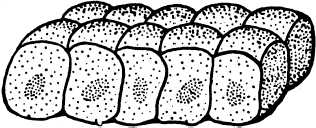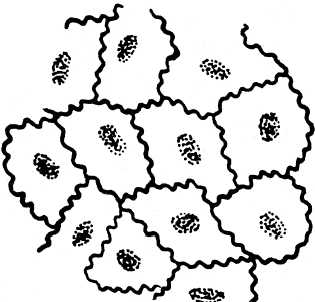and other matter along the surfaces from which they
extend. They also act as a barrier, preventing foreign
matter from entering these cavities.
Squamous Epithelial Tissue
Squamous epithelial tissue is composed of thin
platelike or scalelike cells forming a mosaic pattern
(fig. 1-4). This tissue is found in the tympanic
membrane (eardrum) as a single layer of cells, or in the
free skin surface in multiple layers. Squamous tissue is
the main protective tissue of the body.
Cuboidal Epithelial Tissue
The cells of cuboidal tissue are cubical in shape
(fig. 1-5) and are found in the more highly specialized
organs of the body, such as the ovary and the kidney. In
the kidneys, cuboidal tissue functions in the secretion
and absorption of fluids.
CONNECTIVE TISSUE
This is the supporting tissue of the various
structures of the body. It has many variations and is the
most widespread tissue of the body. Connective tissue
is highly vascular, surrounds other cells, encases
internal organs, sheathes muscles, wraps bones,
encloses joints, and provides the supporting
framework of the body. Structures of connective tissue
differ widely, ranging from delicate tissue-paper
membranes to rigid bones. Connective tissue is
composed of cells and extracellular materials
(materials found outside the cells). Extracellular
materials include fibers and the ground substance.
The ground substance contains proteins, water, salts,
and other diffusible substances. These extracellular
materials give connective tissue varying amounts of
elasticity and strength, depending on the type of tissue
and location. In the following paragraphs we will
discuss the three predominant types of connective
tissue: areolar, adipose, and osseous.
Areolar Connective Tissue
Areolar tissue consists of a meshwork of thin
fibers that interlace in all directions, giving the tissue
both elasticity and tensile strength (fig. 1-6). This type
of connective tissue is extensively distributed
throughout the body, and its chief function is to bind
parts of the body together. Areolar tissue allows a
considerable amount of movement to take place
because of its elasticity. It is found between muscles
and as an outside covering for blood vessels and
nerves. The areolar tissue layer connects the blood
vessels and nerves to the surrounding structures.
1-4
HM3F0105
Figure 1-5.—Cuboidal epithelial tissue.
HM3F0104
Figure 1-4.—Squamous epithelial tissue.
HM3F0106
Figure 1-6.—Areolar connective tissue.





